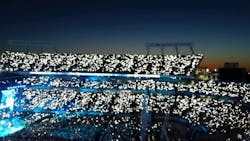Clean Air in Buildings Challenge... and Garth Brooks?
Last month, the U.S. Environmental Protection Agency (EPA) rolled out its Clean Air in Buildings Challenge as part of the federal government’s ongoing efforts to address COVID-19, and other infectious diseases that are spread by airborne particles and aerosols.
The objective of the Challenge is to encourage building owners and operators to improve their indoor air quality (IAQ). Obviously, although improved IAQ can reduce the risk of infection, it cannot completely eliminate that risk. As part of the Challenge, the EPA noted that – for IAQ improvements in public settings – there may be funds available from the American Rescue Plan and the Bipartisan Infrastructure Law.
The Challenge has four major action items:
- create an action plan for clean indoor air in your building that assesses IAQ, plans for upgrades and improvements, and includes HVAC inspections and maintenance;
- optimize fresh air ventilation by bringing in and circulating clean outdoor air;
- enhance air filtration and cleaning using the central HVAC system and in-room cleaning devices; and
- encourage community engagement in your action plan by communicating with building occupants to increase awareness, commitment, and participation in improving IAQ and health outcomes.
In response to the COVID-19 pandemic, there have been notable changes made to the way building HVAC systems are configured and operated. Last June, I had the opportunity to discuss some of them in a live webinar that I presented and, the following month, I summarized that presentation in Clark’s Remarks. Not surprisingly, many of those same improvements are now also addressed by the EPA as part of this Challenge.
Most of the recommendations are obvious to HVAC professionals, but some – such as providing more training for building operators and posting descriptive signage – may not be. In addition to the low-hanging fruit that most buildings have implemented during the pandemic – more efficient filtration (MERV-13 or the highest that the system can accommodate) and more outside air – the Challenge suggests that ultraviolet germicidal irradiation systems, such as those discussed here in April 2020, should be considered, as well. UV light has a shorter wavelength than the visible light which many or most of us now depend on LEDs to provide.
And speaking of LEDs, I recently had the opportunity to see Garth Brooks light up a football stadium with high Kelvin temperature, low-voltage LEDs. As part of his 2022 Stadium Tour, Brooks performed to a crowd of 70,000 at Camping World Stadium in Orlando, FL. When he began to sing his hit song, “The River,” some 80-90% of the fans in the stadium turned on their smartphone flashlights, which was an astounding sight to see.
Assuming an output of 40-50 lumens per phone, Brooks’s fans provided some 3 million lumens! Since it was a clear night, that means the display should have been visible from the International Space Station! I hope the astronauts were "live streaming" the concert which, by the way, was great!
A regular contributor to HPAC Engineering and a member of its editorial advisory board, the author is a principal at Sustainable Performance Solutions LLC, a south Florida-based engineering firm focusing on energy and sustainability. He can be reached at [email protected].
About the Author
Larry Clark
A member of HPAC Engineering’s Editorial Advisory Board, Lawrence (Larry) Clark, QCxP, GGP, LEED AP+, is principal of Sustainable Performance Solutions LLC, a South Florida-based engineering firm focused on energy and sustainability consulting. He has more than two dozen published articles on HVAC- and energy-related topics to his credit and frequently lectures on green-building best practices, central-energy-plant optimization, and demand-controlled ventilation.
